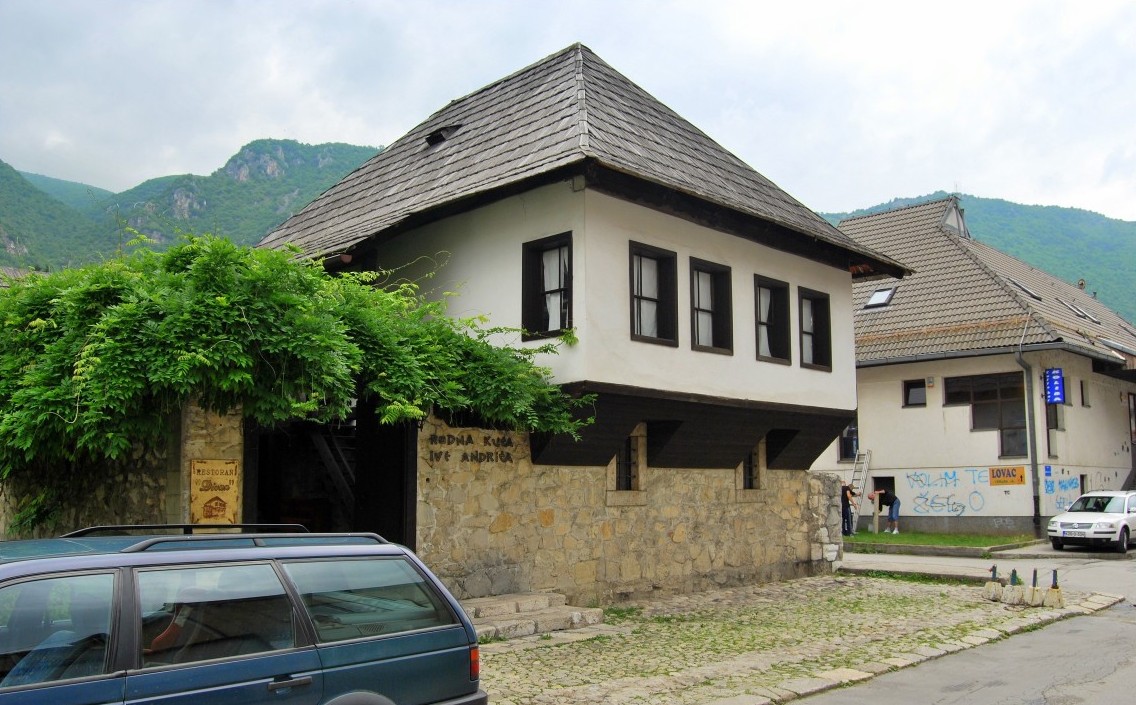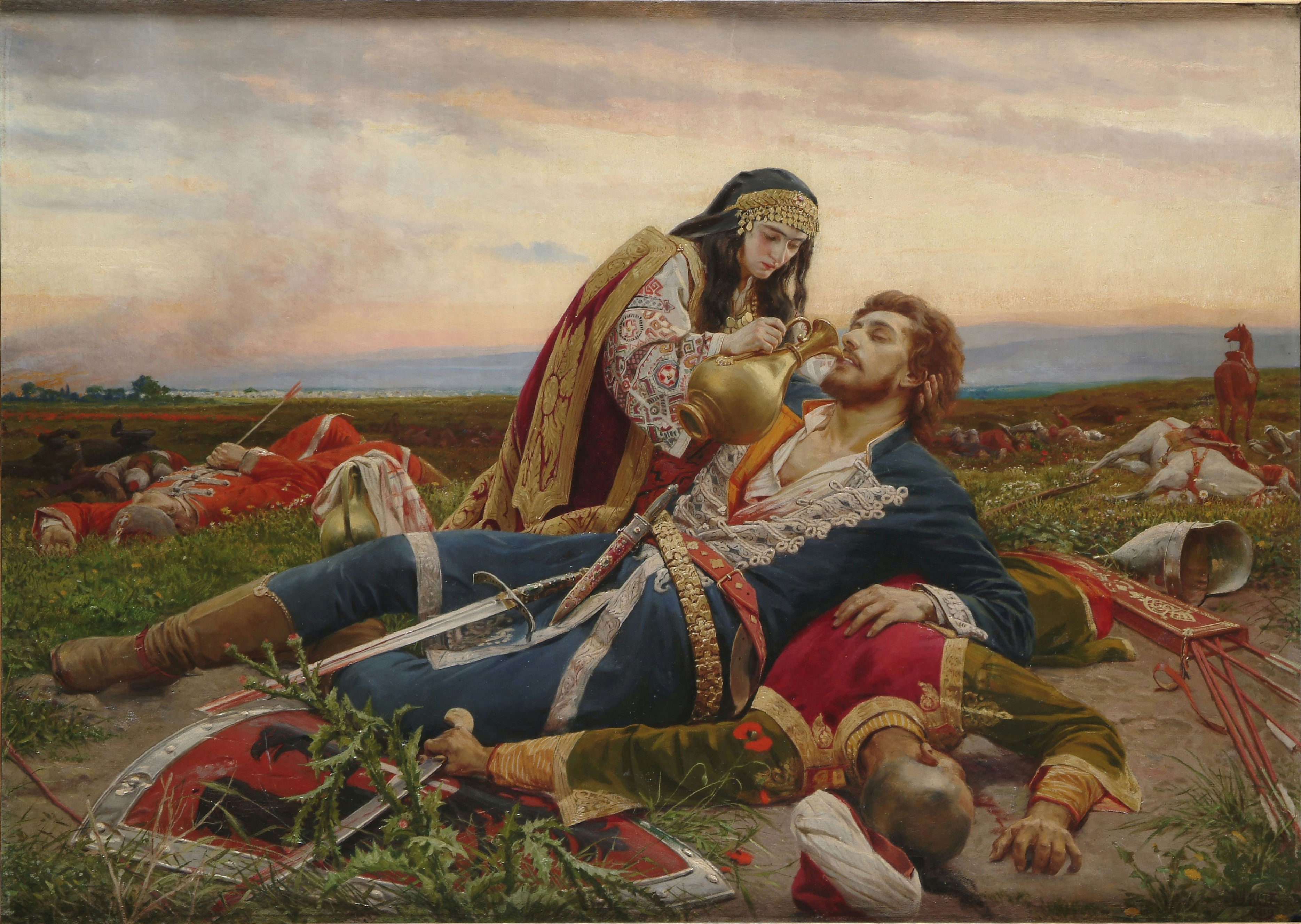|
Museum Of Ivo Andrić
The Museum of Ivo Andrić ( sr, Музеј Иве Андрића / Muzej Ive Andrića) is a museum located in Belgrade, the capital of Serbia. Founded on 10 October 1976, it is dedicated to the Nobel prize winning writer Ivo Andrić. It is operated by the Belgrade City Museum. The library contains 4,502 bibliographical units, rich collection of photographs, numerous Andrić's personal holdings, and writer's study room and the salon, with authentic atmosphere since Andrić's time. History The Museum was founded on 10 October 1976 under the decree of the Ministry for Science and Culture of Serbia. It is located in apartment where Ivo Andrić lived from 1958 until his death. Gallery Spomen-muzej Ive Andrića, Beograd, 01.jpg Spomen-muzej Ive Andrića, Beograd, 06.jpg Zgrada Muzeja Ive Andrića.jpg Spomen-muzej Ive Andrića, Beograd, 02.jpg Spomen-muzej Ive Andrića, Beograd, 09.jpg Spomen-muzej Ive Andrića, Beograd, 14.jpg See also * Tourism in Serbia Tourism in Serbia is ... [...More Info...] [...Related Items...] OR: [Wikipedia] [Google] [Baidu] |
Belgrade
Belgrade ( , ;, ; Names of European cities in different languages: B, names in other languages) is the Capital city, capital and List of cities in Serbia, largest city in Serbia. It is located at the confluence of the Sava and Danube rivers and the crossroads of the Pannonian Basin, Pannonian Plain and the Balkan Peninsula. Nearly 1,166,763 million people live within the administrative limits of the City of Belgrade. It is the third largest of all List of cities and towns on Danube river, cities on the Danube river. Belgrade is one of the List of oldest continuously inhabited cities, oldest continuously inhabited cities in Europe and the world. One of the most important prehistoric cultures of Europe, the Vinča culture, evolved within the Belgrade area in the 6th millennium BC. In antiquity, Thracians, Thraco-Dacians inhabited the region and, after 279 BC, Celts settled the city, naming it ''Singidunum, Singidūn''. It was Roman Serbia, conquered by the Romans under the reign ... [...More Info...] [...Related Items...] OR: [Wikipedia] [Google] [Baidu] |
Serbia
Serbia (, ; Serbian language, Serbian: , , ), officially the Republic of Serbia (Serbian language, Serbian: , , ), is a landlocked country in Southeast Europe, Southeastern and Central Europe, situated at the crossroads of the Pannonian Basin and the Balkans. It shares land borders with Hungary to the north, Romania to the northeast, Bulgaria to the southeast, North Macedonia to the south, Croatia and Bosnia and Herzegovina to the west, and Montenegro to the southwest, and claims a border with Albania through the Political status of Kosovo, disputed territory of Kosovo. Serbia without Kosovo has about 6.7 million inhabitants, about 8.4 million if Kosvo is included. Its capital Belgrade is also the List of cities in Serbia, largest city. Continuously inhabited since the Paleolithic Age, the territory of modern-day Serbia faced Slavs#Migrations, Slavic migrations in the 6th century, establishing several regional Principality of Serbia (early medieval), states in the early Mid ... [...More Info...] [...Related Items...] OR: [Wikipedia] [Google] [Baidu] |
Historic House Museum
A historic house museum is a house of historic significance that has been transformed into a museum. Historic furnishings may be displayed in a way that reflects their original placement and usage in a home. Historic house museums are held to a variety of standards, including those of the International Council of Museums. Houses are transformed into museums for a number of different reasons. For example, the homes of famous writers are frequently turned into writer's home museums to support literary tourism. About Historic house museums are sometimes known as a "memory museum", which is a term used to suggest that the museum contains a collection of the traces of memory of the people who once lived there. It is often made up of the inhabitants' belongings and objects – this approach is mostly concerned with authenticity. Some museums are organised around the person who lived there or the social role the house had. Other historic house museums may be partially or completely re ... [...More Info...] [...Related Items...] OR: [Wikipedia] [Google] [Baidu] |
List Of Nobel Laureates
The Nobel Prizes ( sv, Nobelpriset, no, Nobelprisen) are awarded annually by the Royal Swedish Academy of Sciences, the Swedish Academy, the Karolinska Institutet, and the Norwegian Nobel Committee to individuals and organizations who make outstanding contributions in the fields of chemistry, physics, literature, peace, and physiology or medicine. They were established by the 1895 will of Alfred Nobel, which dictates that the awards should be administered by the Nobel Foundation. The Nobel Memorial Prize in Economic Sciences was established in 1968 by the Sveriges Riksbank, the central bank of Sweden, for contributions to the field of economics. Each recipient, a Nobelist or ''laureate'', receives a gold medal, a diploma, and a sum of money which is decided annually by the Nobel Foundation. Prize Each prize is awarded by a separate committee; the Royal Swedish Academy of Sciences awards the Prizes in Physics, Chemistry, and Economics; the Karolinska Institute awards the Prize ... [...More Info...] [...Related Items...] OR: [Wikipedia] [Google] [Baidu] |
Ivo Andrić
Ivo Andrić ( sr-Cyrl, Иво Андрић, ; born Ivan Andrić; 9 October 1892 – 13 March 1975) was a Yugoslav novelist, poet and short story writer who won the Nobel Prize in Literature in 1961. His writings dealt mainly with life in his native Bosnia under Ottoman rule. Born in Travnik in Austria-Hungary, modern-day Bosnia and Herzegovina, Andrić attended high school in Sarajevo, where he became an active member of several South Slav national youth organizations. Following the assassination of Archduke Franz Ferdinand in June 1914, Andrić was arrested and imprisoned by the Austro-Hungarian police, who suspected his involvement in the plot. As the authorities were unable to build a strong case against him, he spent much of the war under house arrest, only being released following a general amnesty for such cases in July 1917. After the war, he studied South Slavic history and literature at universities in Zagreb and Graz, eventually attaining his PhD. in Graz in 1924 ... [...More Info...] [...Related Items...] OR: [Wikipedia] [Google] [Baidu] |
Belgrade City Museum
The Belgrade City Museum ( sr-cyr, Музеј Града Београда) is a museum located in Belgrade, Serbia. Founded in 1903, the museum operates with several cultural institutions: Ivo Andrić Museum, Princess Ljubica's Residence, Paja Jovanović Museum, Banjica Concentration Camp Museum, Collection of Icons Sekulić, Archaeological Site Vinča and Jovan Cvijić Museum. The Belgrade City Museum contains over 2,500 paintings, graphics, aquarelles and drawings. It contains numerous paintings by Serbian painters Paja Jovanović, Sava Šumanović, Uroš Predić, Nadežda Petrović, Petar Lubarda and others. Among others, it contains paintings and graphics by foreign artists Albrecht Dürer, Miklós Barabás and Jean-Baptiste-Camille Corot. Collections The Belgrade City Museum collections are: * Prehistory * Antique * Middle Ages * Coins and Medals * Arheogical site Vinca * History of Belgrade 1521-1941 * History of Belgrade since 1941 * Fine Arts and Music before 1950 ... [...More Info...] [...Related Items...] OR: [Wikipedia] [Google] [Baidu] |
Tourism In Serbia
Tourism in Serbia is officially recognized as a primary area for economic and social growth. The hotel and catering sector accounted for approximately 2.2% of GDP in 2015. Tourism in Serbia employs some 75,000 people, about 3% of the country's workforce. In recent years the number of tourists is increasing, especially foreign ones for about hundred thousand arrivals more each year. In 2019, tourism generated an income of nearly $1.698 billion, hosting 3 million and seven hundred thousand tourists, half of whom were foreigners. Chinese tourists were the most numerous foreign visitors, followed by tourists from Bosnia and Herzegovina, Bulgaria, Turkey, and Germany. Major destinations for foreign tourists are Belgrade, Novi Sad and Niš, while domestic tourists prefer spas and mountain resorts. Eco-friendly and sustainable tourism has also become very popular among domestic tourists, with many young people visiting various nature reserves and parks in the western and southern part of ... [...More Info...] [...Related Items...] OR: [Wikipedia] [Google] [Baidu] |
Museums In Belgrade
Art museums * Museum of Illusions (Nušićeva 11 * National Museum of Serbia (Trg republike 1a* Museum of African Art, Serbia, Museum of African Art (Andre Nikolića 14) * Museum of Applied Arts (Vuka Karadžica 18* Museum of Contemporary Art (Belgrade), Museum of Contemporary Art (Ušće bb* Legacy of Milica Zorić and Rodoljub Čolaković (Rodoljuba Čolakovića 2), part of Museum of Contemporary Art (Belgrade), Museum of Contemporary Art * Belgrade City Museum (Resavska 40b* Museum of Paja Jovanović, (Kralja Milana 21/VI part of Belgrade City Museum * Zepter Museum (Knez Mihailova 42) ww.zeptermuseum.rs* Gallery of Frescos, (Cara Uroša 20 part of National Museum of Serbia Cultural and historical museums * Historical Museum of Serbia (Trg Nikole Pašića 11) mus.org.rs/en/home* Museum of Yugoslav History (Mihaila Mike Jankovica 6 with 3 buildings: House of Flowers (Tito's tomb), Old museum (Tito's gifts and documents about Yugoslavian history) and Museum 25 May ( ... [...More Info...] [...Related Items...] OR: [Wikipedia] [Google] [Baidu] |
Museums Established In 1976
A museum ( ; plural museums or, rarely, musea) is a building or institution that cares for and displays a collection of artifacts and other objects of artistic, cultural, historical, or scientific importance. Many public museums make these items available for public viewing through exhibits that may be permanent or temporary. The largest museums are located in major cities throughout the world, while thousands of local museums exist in smaller cities, towns, and rural areas. Museums have varying aims, ranging from the conservation and documentation of their collection, serving researchers and specialists, to catering to the general public. The goal of serving researchers is not only scientific, but intended to serve the general public. There are many types of museums, including art museums, natural history museums, science museums, war museums, and children's museums. According to the International Council of Museums (ICOM), there are more than 55,000 museums in 202 countries ... [...More Info...] [...Related Items...] OR: [Wikipedia] [Google] [Baidu] |
Literary Museums In Serbia
Literature is any collection of written work, but it is also used more narrowly for writings specifically considered to be an art form, especially prose fiction, drama, and poetry. In recent centuries, the definition has expanded to include oral literature, much of which has been transcribed. Literature is a method of recording, preserving, and transmitting knowledge and entertainment, and can also have a social, psychological, spiritual, or political role. Literature, as an art form, can also include works in various non-fiction genres, such as biography, diaries, memoir, letters, and the essay. Within its broad definition, literature includes non-fictional books, articles or other printed information on a particular subject.''OED'' Etymologically, the term derives from Latin ''literatura/litteratura'' "learning, a writing, grammar," originally "writing formed with letters," from ''litera/littera'' "letter". In spite of this, the term has also been applied to spoken or ... [...More Info...] [...Related Items...] OR: [Wikipedia] [Google] [Baidu] |
.jpg)




